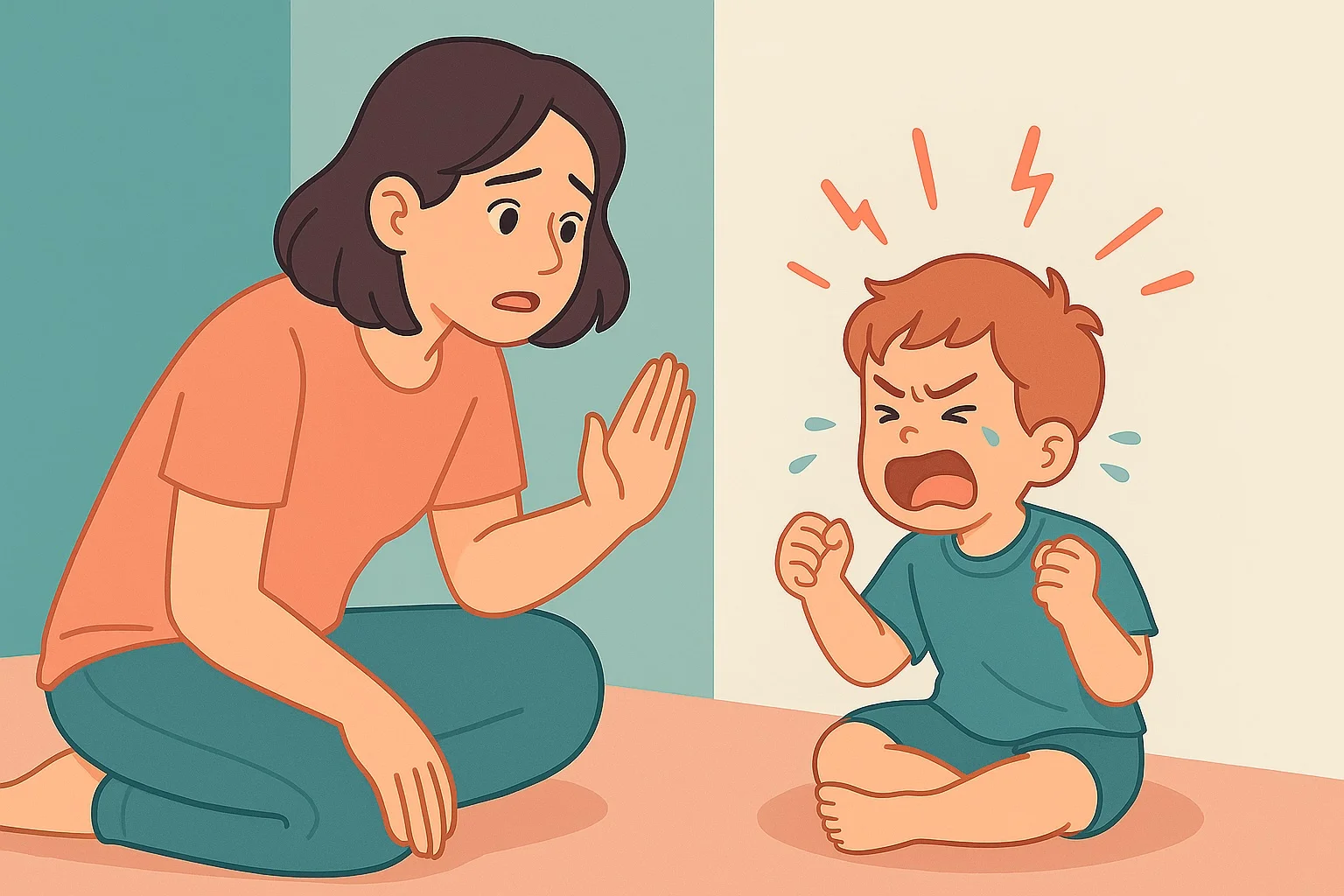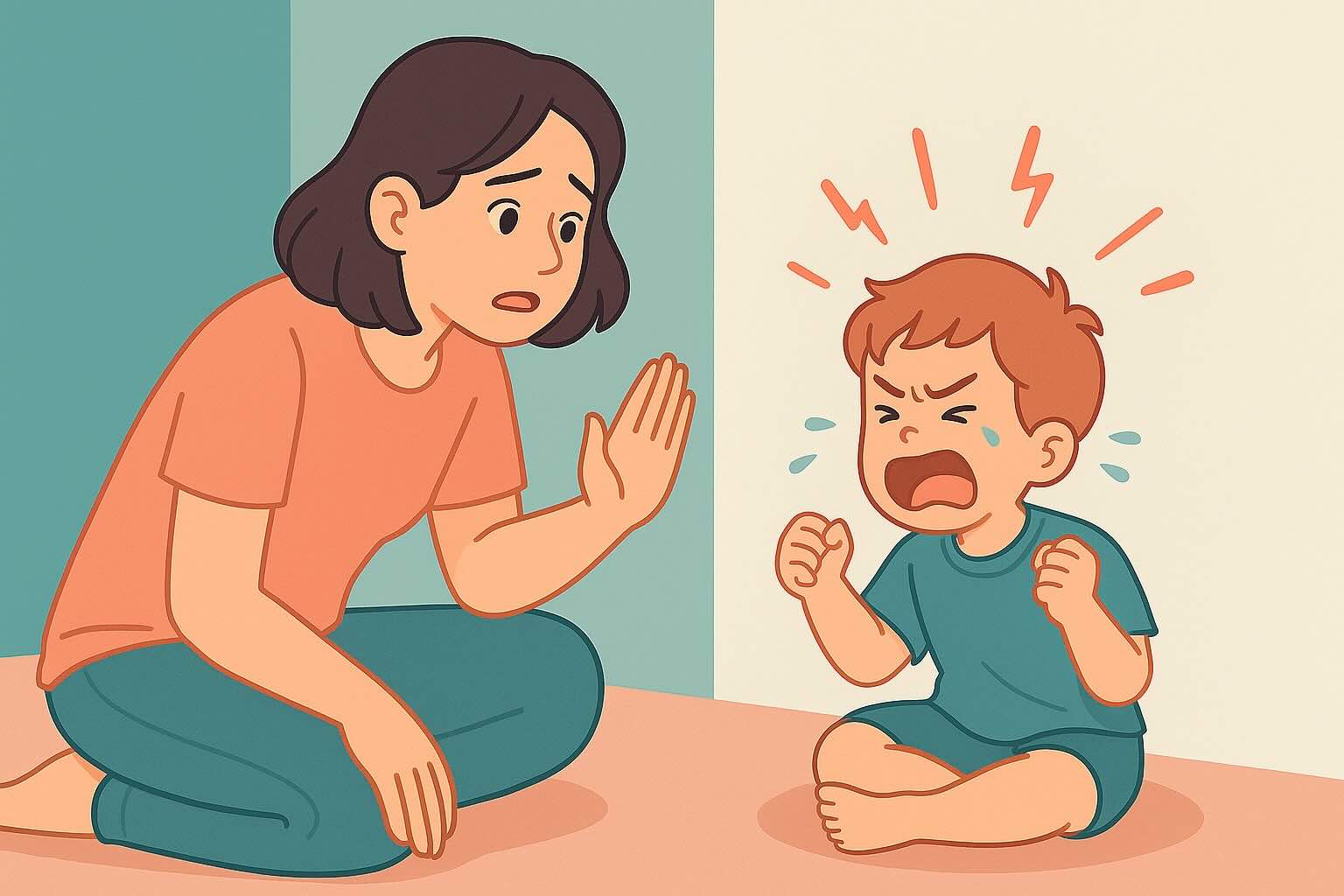Prevent Toddler Tantrums: 15 Strategies That Stop 80% of Meltdowns


Imagine if you could prevent most toddler tantrums before they even started. No more dreading transitions, grocery store trips, or bedtime routines. While tantrums are a normal part of development that can't be completely eliminated, evidence-based parenting programs like Triple P show large effect sizes (SMD = -1.38) for reducing behavioral problems, with most families seeing meaningful improvements within 8-16 weeks of consistent implementation.
The secret isn't avoiding all frustration—it's creating conditions that support your toddler's developing emotional regulation system. This guide will give you 15 evidence-based prevention strategies that address the root causes of most tantrums, helping you build a calmer, more connected relationship with your toddler.
For when prevention doesn't work, our complete tantrum response guide covers the 5-step method for handling meltdowns effectively. To understand why prevention works better than reaction, our tantrum science guide explains the developmental neuroscience behind emotional regulation.
What You'll Learn in This Guide
- The Science of Prevention - Why prevention works better than reaction
- The Big 4 Tantrum Triggers - Physical needs, environment, routine, and emotional factors
- 15 Proven Prevention Strategies - Evidence-based techniques that work
- Age-Specific Applications - How to adapt strategies for your child's development
- Environmental Design - Creating spaces that support emotional regulation
- Routine Optimization - Building predictability that prevents meltdowns (especially important for public outings)
- Early Warning Systems - Recognizing and addressing pre-tantrum signals
Estimated reading time: 8 minutes
Why Tantrum Prevention Works Better Than Reacting
The Toddler Brain: Why Prevention Beats Damage Control
The Developing Brain's Limitations: Your toddler's prefrontal cortex (the "thinking brain") won't be fully developed until their mid-twenties. During tantrums, the emotional brain takes over completely, making logic and reasoning ineffective. Prevention works because it addresses triggers before the emotional brain becomes overwhelmed.
The Window of Opportunity: There's typically a 2-5 minute window between the first trigger and a full meltdown. During this time, your toddler's thinking brain is still partially online and can respond to support. Once the tantrum starts, you have to wait for the storm to pass.
Building Emotional Resilience: Prevention strategies don't just reduce tantrums—they actually help build your child's emotional regulation skills over time. Each successful prevention experience teaches their brain new patterns for handling stress and frustration.
Research Proves Prevention Strategies Reduce Tantrums by 60-80%
Studies show that families using proactive prevention strategies experience:
- Significant reduction in tantrum frequency within 8-16 weeks
- Shorter duration of tantrums that do occur
- Improved parent-child relationship quality
- Better emotional regulation skills in children
- Reduced parental stress and increased confidence
The Big 4 Tantrum Triggers Every Parent Should Know
Research identifies several key categories of tantrum triggers that families can address proactively:
Physical Needs That Trigger Toddler Tantrums
Often the most immediate and preventable triggers:
- Hunger and blood sugar fluctuations
- Tiredness and sleep debt
- Sensory overload or under-stimulation
- Physical discomfort (temperature, clothing, environment)
Environmental Triggers That Overwhelm Toddlers
External conditions that overwhelm developing nervous systems:
- Overstimulating environments
- Lack of predictable structure
- Too many choices or too few choices
- Chaotic or stressful atmospheres
How Routine Changes Trigger Toddler Meltdowns
Changes that create anxiety in developing children:
- Unexpected transitions
- Changes in schedule or expectations
- Rushed timelines
- Lack of transition warnings
Emotional Triggers Beyond Your Toddler's Coping Skills
Feelings that exceed a child's current coping capacity:
- Feeling misunderstood or unheard
- Frustration beyond developmental capabilities
- Lack of emotional vocabulary
- Disconnection from caregivers
⚠️ Critical Research Update (2024): Avoid Digital Emotion Regulation Studies show that using tablets, phones, or screens to prevent or calm tantrums creates harmful dependency cycles and reduces children's natural self-regulation development.
The 15 Proven Prevention Strategies
Physical Needs Prevention (Strategies 1-4)
Strategy 1: The HALT Protocol
Target: Hunger, Anger, Loneliness, Tiredness
Implementation:
- Check for hunger every 2-3 hours with healthy snacks
- Monitor tiredness cues and adjust activities accordingly
- Address underlying frustrations before they build
- Ensure regular connection and attention throughout the day
Age adaptations:
- 12-18 months: Focus heavily on hunger and tiredness
- 18-36 months: Add emotional check-ins and connection time
- 3+ years: Teach children to recognize their own HALT signals
Strategy 2: Strategic Snacking
Target: Blood sugar crashes that trigger emotional instability
Implementation:
- Offer protein-rich snacks every 2-3 hours
- Avoid sugar spikes followed by crashes
- Pack snacks for all outings and transitions
- Time snacks 30-60 minutes before challenging activities
Best prevention snacks:
- Apple slices with nut butter
- Cheese and whole grain crackers
- Hard-boiled eggs
- Hummus with vegetables
- Greek yogurt with berries
Strategy 3: Sensory Environment Management
Target: Overstimulation and sensory overwhelm
Implementation:
- Create calm spaces with soft lighting and minimal noise
- Limit screen time, especially before challenging transitions
- Offer sensory breaks during stimulating activities
- Use noise-reducing headphones in overwhelming environments
Sensory regulation tools:
- Weighted lap pads for calming
- Fidget toys for hands-on learners
- Soft music or white noise for auditory regulation
- Textured items for tactile input
- Avoid digital devices - research shows they impair natural self-regulation development
Strategy 4: Optimal Timing
Target: Fatigue-induced emotional dysregulation
Implementation:
- Schedule challenging activities during your child's best times
- Protect nap times and bedtime routines
- Avoid outings during traditional "witching hours" (4-6 PM)
- Plan easier activities when energy is lower
Energy optimization:
- Morning: High-energy activities, learning, challenging tasks
- Mid-day: Social activities, outings, new experiences
- Afternoon: Quiet activities, routine tasks, connection time
- Evening: Calming activities, routines, preparation for rest
Environmental Prevention (Strategies 5-8)
Strategy 5: Choice Architecture
Target: Power struggles and control battles
Implementation:
- Offer 2-3 meaningful choices throughout the day
- Ensure all options are acceptable to you
- Give choices about HOW, not WHETHER (e.g., "Would you like to walk to the car or skip to the car?" instead of "Do you want to go to the car?")
- Create "yes" spaces where children have full autonomy
Effective choice examples:
- "Red shirt or blue shirt?"
- "Brush teeth first or get pajamas on first?"
- "Walk holding my hand or ride in the stroller?"
- "Story about animals or vehicles?"
Strategy 6: Reducing Decision Fatigue
Target: Overwhelm from too many options
Implementation:
- Limit toy selection to 5-8 items at a time
- Rotate toys weekly to maintain novelty
- Simplify wardrobe options
- Create clear organization systems children can navigate
Organization strategies:
- Use bins with picture labels
- Keep similar items together
- Make preferred items easily accessible
- Store overwhelming choices out of reach
Strategy 7: Predictable Physical Environment
Target: Anxiety from unpredictable spaces
Implementation:
- Create consistent spaces for specific activities
- Use visual cues and labels
- Establish clear boundaries and expectations for each space
- Minimize clutter and overwhelming visual input
Environment setup:
- Calm-down corner with comfort items
- Designated eating area free from distractions
- Play spaces with clear organization
- Quiet spaces for rest and regulation
Strategy 8: Transition Zones
Target: Difficulty moving between activities or locations
Implementation:
- Create physical spaces that help bridge activities
- Use consistent rituals for entering/leaving spaces
- Provide visual and auditory cues for transitions
- Allow processing time between different environments
Transition tools:
- Entryway baskets for outdoor gear
- Hand-washing stations after outdoor play
- Quiet music for calming transitions
- Visual timers for activity changes
Routine Prevention (Strategies 9-12)
Strategy 9: Transition Warnings and Countdowns
Target: Surprise transitions that trigger control battles
Implementation:
- Give 10, 5, and 2-minute warnings before transitions
- Use visual timers children can see
- Create transition songs or rituals
- Acknowledge what they're leaving behind: "It's hard to stop playing. We'll come back tomorrow."
Transition timing:
- 10 minutes: "In 10 minutes, we'll clean up and have dinner"
- 5 minutes: "5 more minutes of playing, then cleanup time"
- 2 minutes: "2 more minutes, then it's time to put the toys away"
- Now: "Time to clean up. You can choose which toys to put away first."
Strategy 10: Visual Schedules and Predictability
Target: Anxiety from not knowing what comes next
Implementation:
- Create picture schedules for daily routines
- Use "first/then" boards for specific activities
- Show the schedule each morning and refer to it throughout the day
- Let children move pictures or cross off completed activities
Visual schedule benefits:
- Reduces constant "what's next?" questions
- Helps children feel in control and prepared
- Supports time concepts and sequencing
- Provides structure during transitions
Strategy 11: Routine Flexibility Windows
Target: Rigidity that makes schedule changes difficult
Implementation:
- Build in 15-30 minute buffer times
- Have "Plan B" options ready
- Practice flexibility during low-stakes situations
- Teach "rolling with changes" as a family skill
Flexibility building:
- "Sometimes plans change, and that's okay"
- Practice changing small routine elements
- Celebrate adaptability when it happens
- Have backup activities ready
Strategy 12: Connection Rituals
Target: Emotional disconnection that leads to attention-seeking behavior
Implementation:
- Schedule 10-15 minutes of uninterrupted one-on-one time daily
- Create special rituals for reunions after separations
- Use transition times for connection (car rides, walking)
- Prioritize connection before correction
Connection activities:
- Special time where child leads the play
- Bedtime snuggles and talking
- Singing together during routine activities
- Physical play like dancing or roughhousing
Emotional Prevention (Strategies 13-15)
Strategy 13: Emotional Vocabulary Building
Target: Frustration from inability to communicate feelings
Implementation:
- Name emotions throughout the day: "You seem excited about the playground!"
- Read books about feelings during calm moments
- Model emotional expression: "I'm feeling frustrated about this traffic"
- Create feeling faces or emotion cards for reference
Emotion teaching opportunities:
- During calm moments, not during tantrums
- Through books, songs, and games
- By observing and naming others' emotions
- Through your own emotional modeling
Strategy 14: Proactive Problem-Solving
Target: Repeated frustrations with the same situations
Implementation:
- Identify patterns in challenging situations
- Practice solutions during calm times
- Role-play difficult scenarios
- Create family strategies for common problems
Problem-solving examples:
- Practice taking turns with a timer
- Rehearse asking for help appropriately
- Create solutions for sharing conflicts
- Develop strategies for disappointment
Strategy 15: Stress Inoculation
Target: Low tolerance for any frustration or disappointment
Implementation:
- Provide small, manageable challenges during calm times
- Celebrate effort and persistence, not just success
- Practice calming strategies before they're needed
- Build confidence through gradual skill development
Appropriate challenges by age:
- 18-24 months: Simple puzzles, stacking, cause-and-effect toys
- 2-3 years: Beginning self-care tasks, waiting for short periods
- 3+ years: Simple chores, multi-step activities, sharing
Age-Specific Prevention Applications
12-18 Months: Foundation Building
Focus: Physical needs and basic environmental management
- Prioritize hunger, tiredness, and overstimulation prevention
- Create very predictable routines
- Use simple transition warnings
- Focus on connection and comfort
Key strategies: 1, 2, 4, 7, 12
18-30 Months: Skill Development
Focus: Adding choice and communication support
- Introduce meaningful choices
- Begin emotional vocabulary building
- Use visual schedules for routines
- Practice problem-solving in low-stakes situations
Key strategies: 5, 6, 9, 10, 13
30+ Months: Independence Support
Focus: Emotional regulation and flexibility
- Expand choice-giving and problem-solving
- Introduce stress inoculation gradually
- Build flexibility and adaptability
- Focus on emotional expression and regulation
Key strategies: 11, 14, 15
Creating Your Prevention Action Plan
Week 1: Assessment and Foundation
- Track current tantrum patterns and triggers
- Implement HALT protocol consistently
- Establish visual schedules for major routines
- Focus on physical needs prevention
Week 2: Environmental Optimization
- Reduce environmental triggers (clutter, overstimulation)
- Introduce meaningful choice-giving
- Create calm spaces and transition zones
- Implement strategic snacking
Week 3: Routine Enhancement
- Add transition warnings to all major changes
- Practice connection rituals
- Begin emotional vocabulary building
- Establish predictable daily rhythms
Week 4: Skill Building and Maintenance
- Introduce proactive problem-solving
- Practice stress inoculation appropriately
- Celebrate prevention successes
- Adjust strategies based on what's working
Measuring Prevention Success
Tracking Metrics
- Tantrum frequency: Count daily tantrums for comparison
- Tantrum intensity: Rate meltdowns on a 1-10 scale
- Successful transitions: Track smooth transitions vs. difficult ones
- Proactive catches: Notice when you prevent a building meltdown
Early Success Indicators (First few weeks)
- Easier morning routines
- Smoother transitions between activities
- Better responses to warnings and preparation
- Increased cooperation with daily tasks
Long-term Success Indicators (With consistent implementation)
- Significant reduction in daily tantrum frequency
- Shorter duration when tantrums do occur
- Improved emotional vocabulary and expression
- Better recovery time after difficult moments
- Increased parent confidence and reduced stress
Important Note: Timelines vary significantly by child, family consistency, and individual factors. Some families see changes within weeks, others need several months of consistent implementation.
Common Prevention Mistakes to Avoid
Over-Prevention Pitfalls
- Avoiding all frustration: Children need to experience manageable challenges
- Giving unlimited choices: Too many options create overwhelm
- Constant negotiation: Clear boundaries are still necessary
- Avoiding transitions: Practice is needed to build tolerance
Under-Prevention Mistakes
- Ignoring physical needs: Hunger and tiredness are major trigger factors
- Inconsistent implementation: Prevention requires consistency to be effective
- Focusing only on the child: Parent regulation and environment matter too
- Expecting immediate results: Building new patterns takes time
Balance Indicators
- Your child experiences manageable challenges without frequent meltdowns
- Boundaries are maintained while needs are met proactively
- Both prevention and response skills are being developed
- The overall family stress level is decreasing
Special Considerations for Neurodivergent Children
Autism and Sensory Processing Differences
Prevention requires different approaches:
- Sensory-first strategies: Focus on reducing sensory overload rather than behavioral modification
- Visual supports: Picture schedules, social stories, and visual timers are especially effective
- Routine predictability: Changes require more preparation and transition time
- Meltdown vs. tantrum distinction: Meltdowns need calming/recovery, not behavior management
ADHD and Executive Function Challenges
Adapted prevention strategies:
- Movement breaks: Build in physical activity before challenging tasks
- Extra transition time: Executive function delays mean more processing time needed
- Clear environmental structure: Reduce distractions and overwhelming stimuli
- Strength-based approaches: Use hyperfocus interests as motivators
When to Consider Professional Evaluation
- Prevention strategies consistently ineffective after 2-3 months
- Extreme sensitivity to sensory input (sounds, textures, lights, crowds)
- Significant difficulty with any change in routine
- Very delayed communication alongside intense behaviors
- Self-soothing behaviors that seem unusual or concerning
Trauma-Informed Prevention Approaches
Recognizing Trauma Responses vs. Developmental Tantrums
Trauma responses may include:
- "Out of nowhere" intense reactions
- Extreme sensitivity to specific triggers (sounds, touch, separation)
- Difficulty trusting adult comfort and support
- Hypervigilance or frequent "fight or flight" activation
Trauma-Sensitive Prevention
- Safety first: Physical and emotional safety must be established before other strategies
- Predictability: Routine and consistency are even more crucial
- Choice and control: Offering appropriate choices helps rebuild sense of agency
- Co-regulation: Patient, consistent adult regulation helps heal dysregulated nervous systems
Real Parent Success Stories
Michelle's Morning Transformation
"Mornings were a disaster until I implemented the HALT protocol and visual schedules. Now my daughter knows exactly what to expect and we've eliminated 90% of our morning meltdowns. The key was addressing her hunger first thing and giving her choices about the order of activities."
David's Grocery Store Success
"Shopping with my 2-year-old went from impossible to manageable once I started bringing snacks, giving him a 'job' in the store, and timing trips for right after his nap. Prevention made all the difference—we went from weekly meltdowns to occasional minor frustrations."
Sarah's Bedtime Victory
"Bedtime battles disappeared when I created a visual schedule, started warnings 30 minutes before bed, and established a connection ritual. My son went from fighting bedtime every night to actually asking to start the routine. It took about 3 weeks of consistency."
Key Takeaways: Prevention Mastery
- ✅ 60-80% of tantrums can be prevented through proactive strategies
- ✅ Physical needs are the biggest trigger - prioritize hunger, tiredness, and sensory regulation
- ✅ Environmental design matters - create spaces that support emotional regulation
- ✅ Predictability reduces anxiety - use visual schedules and transition warnings
- ✅ Choice-giving prevents power struggles - offer meaningful options within boundaries
- ✅ Connection prevents attention-seeking - prioritize relationship and emotional attunement
- ✅ Prevention takes practice - consistency for 4-6 weeks builds new patterns
- ✅ Some tantrums are normal - prevention reduces frequency, not every meltdown
Remember: Prevention isn't about creating a perfect environment—it's about supporting your child's developing emotional regulation system while they learn to handle life's inevitable frustrations.
For hidden triggers that many parents miss, our tantrum triggers guide reveals 15 subtle causes of meltdowns. When tantrums do occur, our communication scripts guide provides age-appropriate language that helps children process emotions effectively.
Ready to transform your daily routines from reactive to proactive? Track patterns, implement prevention strategies, and get personalized support with the RootWise app.
Challenging Moments Support
Access step-by-step parenting strategies, quick tips, and age-specific guidance for difficult situations when you need it most.

24/7 AI Parenting Assistant
Get instant, personalized advice with expert-curated parenting knowledge. Chat with your AI coach anytime, anywhere.

Struggling with tantrums?
Get personalized coaching support available 24/7. Your parenting coach understands what you're going through.
Try RootWise Free →Free Tantrum Scripts
Help your toddler manage big emotions with these strategies and scripts.
Frequently Asked Questions
Need personalized support?
RootWise's AI coach can provide tailored strategies for your specific situation, available 24/7 when you need it most.
Learn More About AI Coaching →



